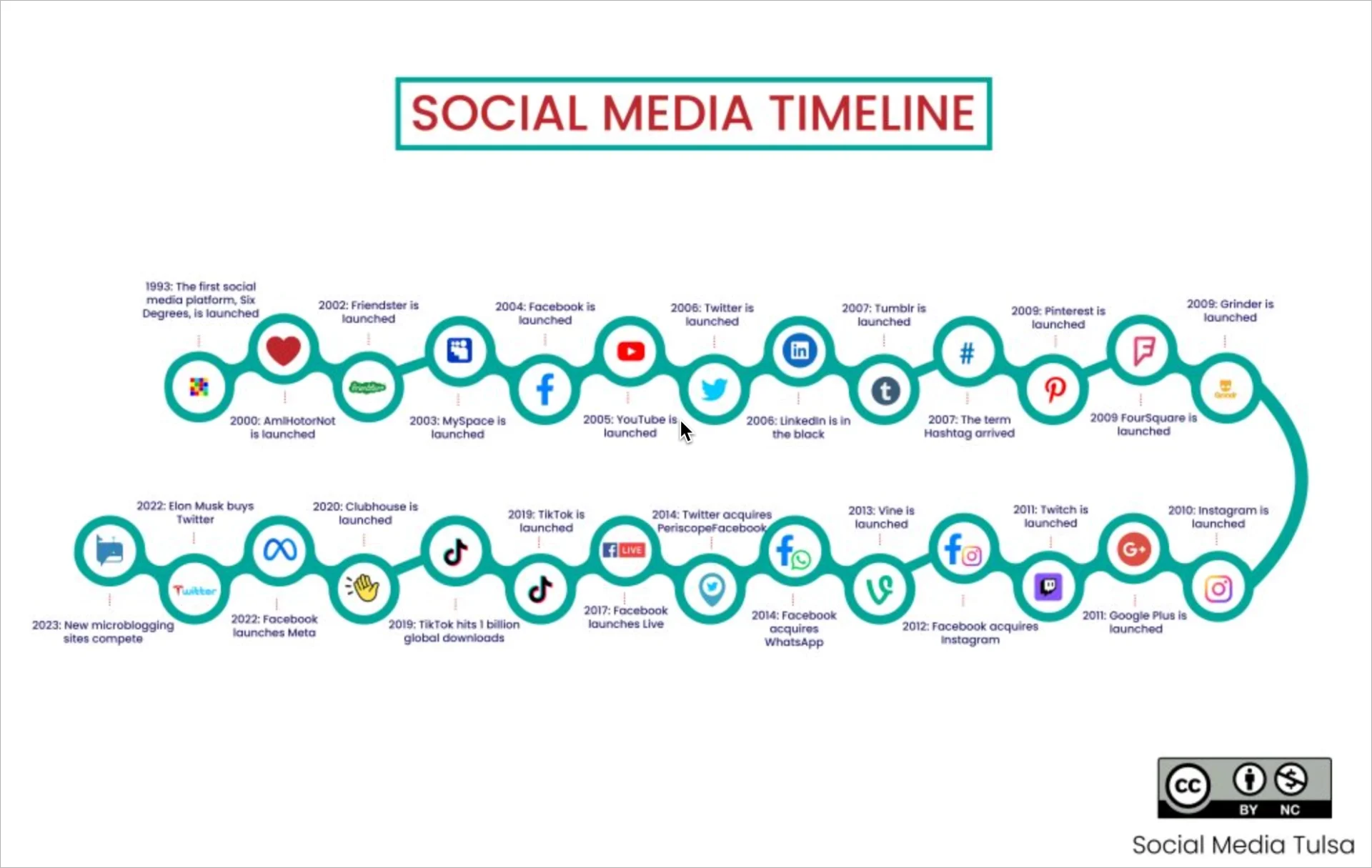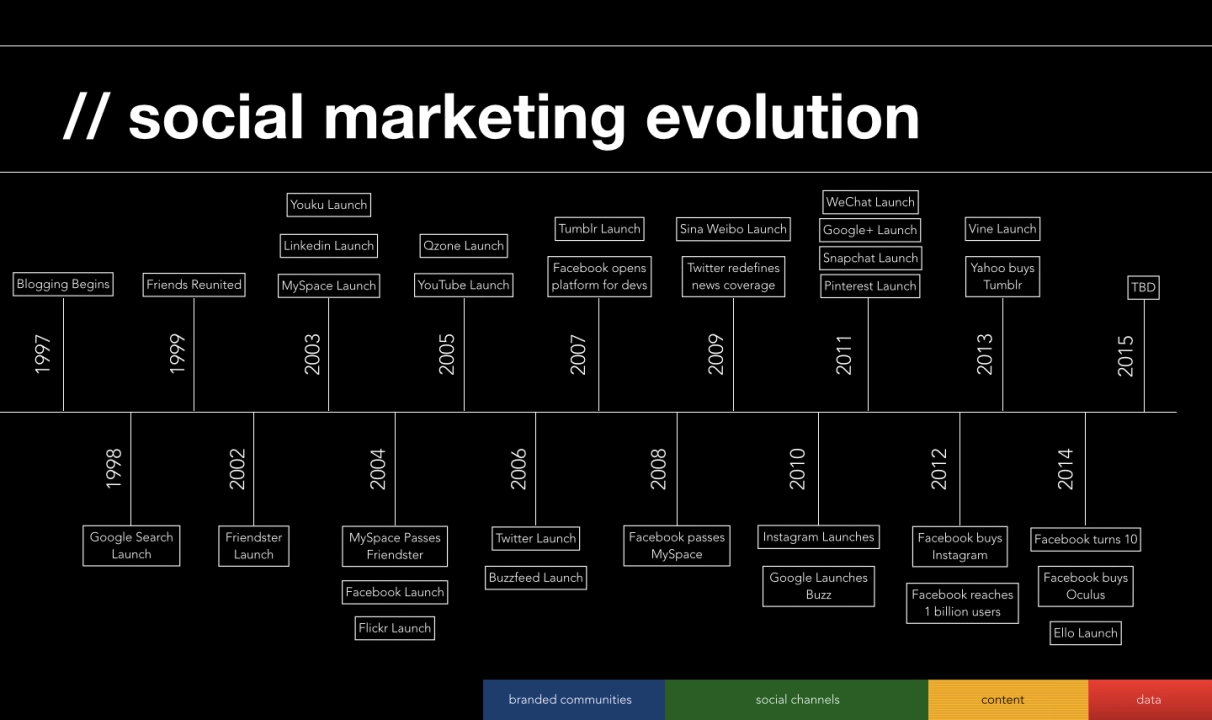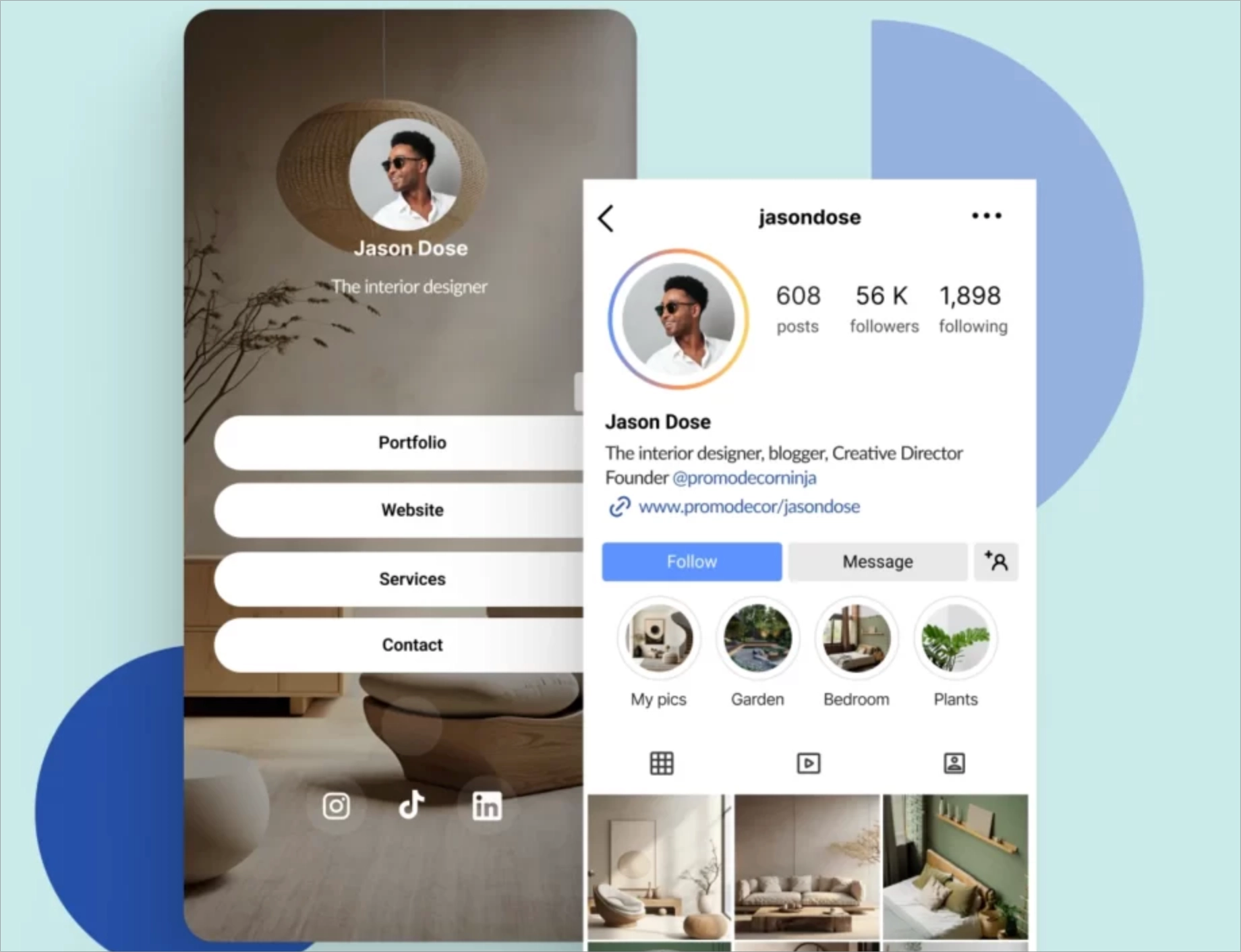The history of social media marketing began with basic online connections and quickly became a major digital strategy. It uses personal networks and real-time interactions to shape how brands reach and influence consumers. Platforms like Friendster and MySpace offered early engagement, but TikTok and Instagram now drive targeted, data-based campaigns.
In 1971, Kotler and Zaltman called for new thinking in social marketing. Their insight laid the foundation for using social platforms in business. By 2007, Facebook launched business pages, shifting social media into a tool for direct marketing. This sparked the rise of influencers, branded content, and features like AR.
Today, people spend over two hours a day on these platforms. That attention forces brands to create meaningful, responsive content – and connect it to landing pages that capture leads or drive bookings. Social media marketing has evolved from one-way posts to interactive, real-time strategies that blend content, data, and technology.

What Is The History of Social Media Marketing?
The history of social media marketing began in the early 2000s with platforms like Friendster and MySpace. Friendster, launched in 2002, let users build profiles and connect online – an idea that quickly gained global attention. MySpace followed in 2003, offering profile customization and attracting both users and brands interested in online engagement.
Facebook entered in 2004, first for college students, and opened to the public by 2006.
Twitter launched in 2006, adding real-time communication, which helped brands respond quickly and stay visible.
In 2006, Google acquired YouTube, turning video into a key marketing tool. Instagram launched in 2010, pushing visual storytelling to the forefront. As platforms grew, so did their marketing capabilities. Facebook Ads appeared in 2007, followed by Twitter’s promoted tweets in 2010, offering precise audience targeting.
By the 2010s, social media marketing had shifted from basic posts to strategies using data, influencers, and tailored content. Analytics tools and platform algorithms helped brands optimize performance. Social media marketing became a central part of digital growth – flexible, fast-moving, and deeply connected to user behavior.
Social media marketing changed the game. Build your next big move with Landingi’s tools!
When Did Social Marketing Concept Start?
The social marketing concept began in the early 1970s, introduced by Philip Kotler and Gerald Zaltman. They proposed using marketing strategies to influence behaviors that benefit society, not just sell products. This marked a shift in how marketing could support public goals like health, education, and environmental protection.
Early campaigns focused on actions like quitting smoking, saving water, and getting vaccinated. These efforts relied on understanding what motivated people and how to communicate in a way that connected emotionally. Tools included posters, public service ads, and community outreach.
Although these methods were offline, they shaped the foundation for today’s social media marketing. The core ideas – audience insight, emotional messaging, and encouraging behavior – remain central, even as channels and formats have changed.
How Has Social Media Marketing Evolved Over The Past Few Decades?
Social media marketing has evolved significantly over the past few decades, shifting from rudimentary online connections to a highly strategic and dynamic approach to engaging audiences.
1990s
In 1997, Six Degrees launched as the first social network. It let users build profiles and connect with others. At the time, these platforms were novelties. Most businesses didn’t see their marketing value yet, and the focus remained on personal interaction.

2000s
The early 2000s brought Friendster and MySpace, which introduced more customization and community engagement. Brands began to experiment by setting up pages and sharing updates. Facebook’s launch in 2004, and its business tools in 2007, shifted social media from social use to strategic marketing. Twitter, launched in 2006, added real-time communication, allowing direct customer interaction. Ad services and user targeting became key tools by the end of the decade.
2010s
This decade introduced visually focused platforms like Instagram and Pinterest, launched in 2010. LinkedIn expanded into B2B marketing, while influencer marketing became mainstream. Businesses used algorithms, data, and analytics to increase reach and measure results.
The rise of mobile apps in this period dramatically altered the way users interacted with social media, offering unprecedented convenience and accessibility. Social media platforms such as Snapchat and Instagram leveraged their mobile-first designs to capture and engage younger audiences.
2020s
Today’s platforms – like TikTok, YouTube, and Instagram – prioritize short-form video, live streams, and user content. AI and AR features enhance interaction, and paid subscriptions offer brands new ways to engage. These platforms provide detailed user data, making ad targeting and performance tracking more precise than ever.
Across all decades, the goal has stayed the same: building real connections through new and smarter ways to reach people.
Create a landing page that works for today’s social media-driven world!
When Was Social Media First Used For Marketing?
Social media was first used for marketing in the mid-2000s, starting with platforms like MySpace and Facebook. Businesses began by creating pages to share updates and connect with audiences. These early strategies were organic, relying on likes, comments, and shares to build visibility.
Content was usually informative or entertaining, designed to engage users without paid promotion. As these platforms grew, they became more central to digital marketing plans. The introduction of paid advertising features soon followed, letting businesses expand their reach and target users with greater accuracy.
This transition turned social media into a central pillar of digital marketing strategies and reshaped online advertising.
How Has Social Media Marketing Changed Over Time?
Social media marketing has changed drastically over time, evolving from basic content sharing to a sophisticated, strategy-rich discipline that incorporates advanced technologies, diverse engagement methods, and the power of social media influencers. In the early stages, brands relied on organic posts to build community engagement. Platforms like MySpace and Facebook offered basic tools for businesses to share updates and start two-way conversations.
That changed in 2007 with the launch of Facebook Ads. Businesses could now run targeted campaigns using user demographics, interests, and behavior. As competition grew, paid promotions became essential for staying visible and reaching larger audiences.
For instance, brands like Daniel Wellington used Instagram influencers to boost product visibility and build trust with consumers. Influencers brought credibility and direct access to engaged followers.
Today, social media marketing includes dynamic ads, A/B testing, and predictive analytics. These tools help brands personalize content and improve performance in real time. Platforms offer interactive features (like live streaming, polls, and AR filters) that increase user engagement and time spent on content.
For example, Sephora uses AR for virtual try-ons, allowing users to test makeup through their phones. This blend of e-commerce and interactivity shows how social media has become a complex system combining creativity, data, and real-time engagement.

What Did Marketing Look Like Before Social Media?
Before social media, marketing used offline channels like TV, radio, print, and outdoor ads to reach large audiences. TV commercials were a major tool, with brands like Coca-Cola and McDonald’s running campaigns that became widely recognized. Radio ads targeted commuters, while newspapers and magazines carried full-page brand messages.
Outdoor advertising relied on billboards in busy areas, such as Times Square, to grab public attention. Marketers also used direct mail to send catalogs and offers to households, and telemarketing to speak with customers directly. These methods were effective but slower and less flexible than digital options today.
Campaign results came in through surveys, focus groups, and sales data – often weeks or months later. For example, a new product launch would be followed by delayed feedback from mailed questionnaires or retail performance.
However, they lacked the immediacy, interactivity, and precise targeting that social media marketing now provides, highlighting the transformative shift brought by digital platforms.
What Were The Marketing Strategies Before Social Media?
Before social media, marketing strategies relied on direct mail, telemarketing, mass media, sponsorships, public relations, loyalty programs, and referrals. These approaches were shaped by the communication tools of the time and required more planning and resources than digital marketing today.
Direct Mail
Direct mail campaigns were widely used, with companies sending catalogs, postcards, or offers to homes. Brands like Sears and Roebuck reached rural buyers through mail-order catalogs, expanding their customer base far beyond urban centers.
Telemarketing
Telemarketing allowed businesses to speak directly with potential customers. Though often seen as intrusive, it gave service-based industries like insurance or telecom the chance for real-time interaction and feedback.
Mass Media Advertising
TV, radio, newspapers, and magazines played a central role in brand storytelling. Campaigns like Coca-Cola’s “Share a Coke” or Apple’s “1984” ad showed how visuals and emotion could shape public perception. Billboards in places like Times Square added constant brand presence in high-traffic locations.
Event Sponsorships
Sponsoring sports, music festivals, or community events helped companies connect with audiences through shared interests. Trade shows gave businesses face-to-face exposure with potential customers and partners.
Public Relations
Public relations efforts, such as press releases and media coverage, were instrumental in shaping brand perception. Companies like General Electric frequently issued press releases to highlight product launches or company milestones, ensuring media attention and public awareness.
Loyalty and Referral Programs
Loyalty programs, such as American Airlines’ frequent flyer miles, encouraged repeat purchases. Referral incentives boosted word-of-mouth marketing, which held strong value before online reviews became common.
These strategies were powerful but less agile than digital marketing. Feedback came slowly, and changes took time. Yet they laid the groundwork for the customer-focused, engagement-driven tactics used today.
When Was The First Social Media Platform Launched?
The concept of social media began in 1997 with the launch of SixDegrees.com, widely regarded as the first social networking site. It let users create profiles, connect with friends, and send messages – features that became core to later platforms.
Before that, Classmates.com launched in 1995, offering a way to reconnect with schoolmates. However, it didn’t include user profiles or direct interaction in the way modern platforms do.
Six Degrees was the first to combine profiles and personal networks, setting the stage for platforms like MySpace in 2003. MySpace expanded the concept with music sharing and customizable pages, changing how people engaged online.
Step into the future of online engagement. Use our landing page templates to share your story!
What Triggered The Rise of Social Media Marketing?
The rise of social media marketing began in the late 2000s, driven by the rapid growth of platforms like Facebook and Twitter. At the same time, smartphones and faster internet made social media easy to access anywhere, anytime. The launch of the iPhone in 2007 and the spread of 3G and 4G networks boosted daily usage and user engagement.
Businesses saw that people were spending more time online and began building a presence on these platforms. Facebook launched business pages in 2007, followed by Facebook Ads, which allowed precise targeting based on user interests and behavior. Twitter added promoted tweets in 2010, helping brands reach larger audiences with real-time updates.
Visual platforms also played a major role. YouTube became a video marketing hub after Google bought it in 2006. Instagram, launched in 2010, made visual storytelling a central part of brand strategy. These tools gave businesses new ways to connect with users through product demos, tutorials, and behind-the-scenes content.
When Did Social Media Become Popular for Advertising?
Social media became popular for advertising around 2010, when platforms like Facebook introduced advanced ad tools that revolutionized digital marketing. Facebook Ads allowed businesses to target users by demographics, interests, and behavior, making campaigns more accurate and effective than traditional ads.
Soon after, Instagram and Twitter launched their own ad features. Instagram’s visual format helped brands showcase products through photos and videos. Twitter introduced promoted tweets, letting companies reach users during live events or trending conversations.
Influencer marketing also gained momentum. Brands began partnering with content creators who had loyal followings. For instance, fitness companies worked with influencers to promote gear or supplements in a relatable way.
Platforms supported this shift by offering affordable, scalable ad tools with strong targeting and performance tracking. As a result, social media became a core advertising channel, valued for its precision, flexibility, and high engagement.
When Did Social Media Campaigns Become Integral to Landing Pages?
Social media campaigns became integral to landing pages in the early 2010s, when marketers began linking ads directly to focused calls to action. Driving users from social platforms to targeted landing pages helped businesses maximize conversions and track campaign success more accurately.
As tools like Facebook Pixel and Google Analytics improved, it became easier to gain insights into user behavior and adjust strategies in real time. This shift made landing pages a key part of converting social traffic into leads or sales.
Landing page platforms like Landingi made this process faster and more accessible. With templates, a drag-and-drop editor, and built-in integrations, Landingi allows marketers to build professional landing pages without coding. Features like A/B testing capabilities and analytics offer clear data on what drives results, helping teams launch better-performing campaigns.

For example, a fashion brand running an Instagram ad can use Landingi to build a landing page that highlights the promoted collection, includes a discount code, and offers direct purchase links. This smooth transition increases the chance of conversion and ensures ad budgets are spent efficiently.
Marketers also benefit from Landingi’s insights into user behavior, which help refine future campaigns for even stronger results.
To build landing pages that work seamlessly with your social campaigns, try Landingi for free and see how easily you can boost conversions.






